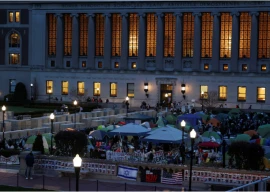

The patients sleep together in the six rooms at the centre, that have been stripped off everything apart from a blanket and pillow per person. PHOTOS: MUJTABA NASERI
The centre was opened in December 1989 by a man named Mohammad ‘Milo’ Ismail, a resident of Marriabad, which is home to nearly 300,000 members of the Shia Hazara community. Initially, MST was a 25-bed rehabilitation institute known as the Public Welfare Society for the control of Drug Abuse. Some locals say Milo was a former drug addict who kicked his habit and formed the centre to help others do the same. For others, Milo’s story starts when he contested and won local elections and promised to rid Marriabad of its dealers.
Both stories have the same ending — just eight months after the centre opened its doors, a supplier named Jawad shot Milo on the street. The centre was renamed the Milo Shaheed Trust and now, after an estimated 11,641 addicts have been treated here, Milo was posthumously awarded the Tamgha-e-Shuja for his bravery by the Pakistani government.

The doctors and dispensers working at MST often offer their services free of charge while the counselors are paid a stipened. PHOTOS: MUJTABA NASERI
To enter Marriabad, you must pass a security checkpost and state the reason for your visit or the name of a contact who lives here and can vouch for you. But at the centre, there is no security pat down. A whiteboard in the reception is testament to the centre’s success in treating drug users. It is updated every day to show the total number of under-treatment patients which currently includes Pashtuns (the highest number, at 32), Hazaras, Baloch, Punjabis, Sindhis, Kashmiris, Hindus and Christians, as well as Afghans and Iranians.
Inside, Adil sits at a desk behind stacks of white case files. After tending to patients this afternoon, he met the centre’s cleaning committee and chided them for not doing a good enough job that morning. Some of the patients helped sweep and hose down the floors and at 5:00pm, Adil spent 20 minutes coaxing them to exercise. “I get them to do jumping jacks, stretches — nothing too strenuous as I don’t want them to burn calories,” he explains. “We’re trying to build their bodies back up.” Exercise is followed by chai, sometimes green tea, and — if they’re lucky — syrupy jalebis that Adil buys on his way to work. “Sweet things help to reduce the effects of the drugs,” he explains.

Each patient is fed a rich diet, which includes buttered parathas and chai in the mornings, vegetables, chicken, meat or lentils and rice for lunch and dinner. PHOTOS: MUJTABA NASERI
Treatment
The centre has a no-frills approach to rehabilitation. During the first stage, the addicts go through withdrawal for a period of 10 days. This is followed by a week to 10-day ‘detox’, during which the centre hopes the drugs are cleared from the patient’s system. The final stage is rehabilitation, which can last from a month to three months, and includes physical and mental rehabilitation. However, before any of this, a crucial point needs to be established. “The one condition we have before we let a patient in here is that they must want to do this, they must commit to it otherwise it’ll never work,” explains Adil.
Adil says that often addicts arrive at the centre of their own volition, while others are brought in by family members. Many cross the border from Afghanistan or Iran, seeking treatment at MST. “A lot of our patients from Iran are opium addicts and if they’re unable to find it in Quetta, they turn to heroin, crystal meth or over-the-counter medicines and painkillers,” he says. Those coming from Afghanistan are usually heroin users.

Despite the success stories, MST has many patients return to the centre within days after leaving. The patient relapse rate is nearly 75%. PHOTOS: MUJTABA NASERI
Even though they may agree to enter the MST programme, patients are often unable to take the grueling withdrawal period. While some try and escape or jump out of the car during visits to the doctor, others act out physically. A pair of handcuffs hangs from the wall in the reception and a supervisor, Iftikhar, says, “If you are bound to a chair, your hands cuffed for hours and if you cannot even swat a fly if it sits on your face, you’ll calm down pretty soon.”
Each patient must pay Rs8,500 a month, which covers the cost of meals and medicines. “Some people think this is too much, but if the addicts are spending roughly Rs15,000 to Rs30,000 a month on their drugs, they can afford to pay Rs8,500 for their treatment,” Adil says. He spends much of his free time chasing payments from patients who have left the centre. Many say they are simply unable to pay for the treatment and according to a 2013 survey by the United Nations Office on Drugs and Crime, 76% of opiate users say they want help but do not seek it due to an inability to pay.
And so, MST has set up new free treatment facility just minutes from the centre. The new centre — a one-year project funded by USAID — has 25 patients and charges patients Rs1,000 to cover the costs of tests. If a patient tests positive for HIV or Hepatitis, the centre declines treatment since they cannot risk the virus spreading among other patients. Most of the HIV-positive patients die within a year after they are turned away.

The patients are made to do light excercises every evening for 20 minutes in order to help them strengthen their bodies. PHOTOS: MUJTABA NASERI
When patients are accepted at MST, they are first briefed on the rules of the centre — don’t discuss religion, politics or your past, don’t fight with anyone and don’t try to run away. All patients are then bathed, deloused and their heads are shaved. Each patient is given a teal-coloured uniform, a thin blanket and pillow. The six rooms they stay in are stripped of any objects that can be used by the patients to harm themselves or others. Despite that, hardly a week goes by without the glass windows in these rooms smashed.
Recovery
The food committee makes sure each patient is fed a rich diet, which includes buttered parathas and chai in the mornings and vegetables, chicken, meat or lentils and rice for lunch and dinner. During their first few days at the centre, however, many patients are unable to stomach the food, eating only yogurt or lassi as they go cold turkey. After 10 days, while they are detoxing, the patients meet with one of the three counselors to create a case history.
While the case history sets out a course of treatment, questions about the patient’s caste or tribal affiliations and education helps staff in allocating a ‘monitor’ to the patients. Like head boys at a school, the three or four ‘head monitors’ lead teams of assistant monitors, shift in-charges and day and night chowkidars, summing up to a total of 12 full-time employees. A monitor must remain present in the patients’ rooms around the clock. “The monitors are all voluntary,” Adil says. “We give them a room to stay in, but we’re unable to pay them. For them, it is an honour to do this job.”

Similarly, doctors and dispensers who work with the centre often offer their services gratis, while counselors are paid a stipend. Every patient in the ‘rehabilitation’ stage meets their counselor every morning and attends group sessions. MST has worked with Dr Ghulam Rasool, the head of the psychiatry department at Bolan Medical College, for the last 10 years to treat addicts with psychological problems.
With staff having no formal training, the MST system is a constant work in progress — everyone’s learning on the job. “Every year we think of new ways to deal with addiction. And once a mistake is made, we cannot repeat it,” Adil says. Surviving on local and international grants and the patients’ fees, the centre struggles to cover its monthly costs of up to Rs700,000. Just three months ago, MST’s chairman had to contribute Rs500,000 from his personal funds to keep the centre running. A lack of funding also means that the centre cannot branch out into areas such as social rehabilitation, which is a key to successful rehabilitation.
The patients
At MST, patients aren’t just battling addiction. For many, drug use goes hand-in-hand with psychological issues. “The most common problem I see in MST patients is schizophrenia,” says Dr Rasool. “There are also a lot of patients with bipolar or affective disorders, personality disorders, drug-induced psychosis, depression, paranoia and anxiety.” He elaborates that younger patients tend to suffer more from drug-induced disorders.

While initially Adil says the centre cannot take in female patients, he later admits that there have been a handful over the years. Many of these women are from Dalbandin in Balochistan and between the ages of 20 years to 30 years. “The women who have been admitted in my seven years here have been involved in the cultivation and supply of drugs like chars or heroin,” he says. “There aren’t any places that cater to female addicts and they’re often using drugs because their husbands do [the same] or they turned to drugs like heroin as a form of pain relief.” When female patients are admitted, only the most senior volunteers work with them, and it is often difficult to get the woman to talk to a male counselor.
The few female patients that have been brought in to Dr Rasool’s clinic suffer foremost from anxiety. Many, he says, are ‘hysterical’ — they babble, hallucinate or suffer from partial paralysis. “We’re lucky that the medicines I need to prescribe for these patients — for example SSRIs or tricyclics for those with depression — are now so commonly used in Pakistan that we don’t have a problem finding them in Quetta,” he says.

Many patients who enter MST are also saaqis (dealers and suppliers) who scout out potential clients and see how the rehabilitation system works.
The rate of success
“During counseling, we try to appeal to these men as humans with a bad habit, not a disease. We look at the problem from intellectual and religious points of view,” explains Adil. Sometimes, this logic works such as in the case of a young man, from Quetta’s Saryab Road, who arrived at the centre crying incoherently. Three months later, he kissed Adil’s hands and walked out of MST. Many, however, return to the centre within days of leaving as 75% of the patients relapse.
Hazara Democratic Party leader Bostan Ali says the drug problems have worsened, particularly among the Hazara community as they have been virtually ghettoised in Marriabad and Hazara Town due to increasing attacks on Hazara Shias. “Look around you,” says Bostan, as he walks down Alamdar Road. “When there are no attacks, we’re happy, we’re out on the street.” Shops are brightly lit, children play cricket on the street, men sit on benches along the sidewalks and women meander in and out of shops. Beyond Alamdar Road are the mountains, a winding twinkling path of lights illuminating the way for many who live here. Within minutes, however, it could all go silent. “After the attacks increased, Marriabad and Hazara Town have been closed off,” Bostan explains. “People living here feel depressed. They are cut off from the city and many of them [who] don’t make enough money turn to drugs,” he says.
Sanam Maher is a subeditor on The Express Tribune national desk. She tweets @SanamMKhi.
Published in The Express Tribune, Sunday Magazine, October 19th, 2014.
COMMENTS (4)
Comments are moderated and generally will be posted if they are on-topic and not abusive.
For more information, please see our Comments FAQ



































1713853507-0/MalalaHilary-(2)1713853507-0-270x192.webp)








Quetta's Hazara community is the pride of the valley. They add to the city's cultural diversity. The work of Mylo Shaheed Trust is one example of the great contributions of this community to the city.
I guess majority of patients in their centre are Heroin addicts. The high relapse rate amongst these patients is a matter of concern but the trend is similar to what has been observed in many other countries. I am sure the team at the centre are trying their best but heroin addiction is a very complex medical problem and even in developed countries, it is difficult to treat it. A small piece of advice based on my limited experience and superficial knowledge to the team would be:
The therapeutic approach of considering heroin addicts as ''humans with a bad habit'' is an incorrect one. Heroin addiction is a disease. In fact, it is considered to be a complex brain disorder in which the drug (Heroin) changes the way the brain functions. Heroin addicts should be seen in the same way that we see, say, someone with a liver or kidney problem (we don't blame patients for developing kidney problems). I am stressing on this point because it is incorrect, from a medical perspective, to judge heroin addicts as people with bad habits. It affects their motivation and the resulting guilt is harmful psychologically for the patients. I would encourage to the team to read and implement evidence based practices in the management of heroin addicts. There are some good treatment guidelines available online (I would suggest the Indian Psychiatry Society's guidelines though Australians too have done some good work on this issue).
I notice in this news that the centre declines admission to patients who test positive for HIV or Hepatitis B/C. I think its an incorrect strategy. These infections are blood-borne and do not spread by living or eating together or by shaking hands and hugging. Needle exchange programs, availability of condoms in the cells are some measures that can effectively prevent transmission of these infections. I would request the centre to change their policy of not accepting such patients in the centre. I encourage the staff to make maximum use of the internet and search of guidelines on management of heroin addiction.
Please do not take my opinion as criticism on the work of the team. I am convinced that the team of Mylo Trust are wonderful people and are doing their best. Its heroin addiction that is a complex problem and medical management alone cannot always succeed if socio-economic, societal and environmental factors are not addressed simultaneously.
My very best regards to the team of Mylo Shaheed Trust. I will try to pass by the centre when I next come to Quetta valley - our home.
Excellent Work and keep it up, God Speed
My salute to Hazara people. Despite being the worst victim of sectarian terrorism, no one can beat their positive attitude and spirit of survival.
Amazing organization and extra ordinary job. Thanks Express for bringing this trust into lime light.